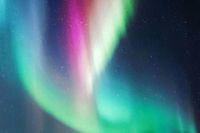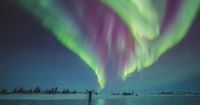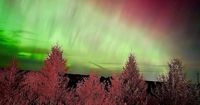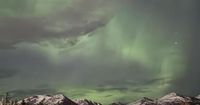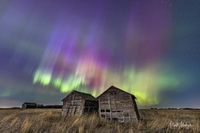The celestial dance of the Northern Lights will make an appearance over parts of Canada this week, thanks to a geomagnetic storm hitting Earth. Aurora watchers are in for a treat as the National Oceanic and Atmospheric Administration (NOAA) has issued a storm alert for Tuesday and Wednesday nights, March 25 and 26, 2025, that recommends looking up after dark.
Data from NOAA suggest high aurora activity is expected in northern Ontario, Quebec, and the prairies on Tuesday, while southern Ontario has a lower probability of viewing but still lies within the "viewline" where sightings might occur.
The predicted storm's intensity will wane somewhat on Wednesday, but it remains possible to catch a glimpse of the aurora borealis across southern Ontario and the Greater Toronto Area (GTA) if conditions align favorably.
The best time to witness this dazzling display is typically around midnight, with peak visibility occurring within an hour or two before or after. As geomagnetic activity heightens, the chances of successive shows expand toward both evening and morning hours.
Traditionally, spring and fall around the equinoxes are prime times for aurora viewing. During this period, the geomagnetic interactions created by solar winds tend to be more potent. Indeed, on Tuesday, the auroras could glide further from the poles, becoming brighter and showcasing more dynamic movements.
"During a severe space weather storm, these errors can increase to tens of meters or more," NOAA experts explain. While the auroras dazzle visually, the storm may also lead to disruptions in the ionosphere, potentially affecting radio communications and global positioning systems (GPS). As the storm intensifies, the reliability of satellite navigation could diminish, creating challenges for those dependent on these technologies.
Many Canadian provinces should prepare for views of the auroras as forecasts indicate the possibility of G1 (minor) geomagnetic storm levels on Monday, March 24, and up to G2 (moderate) levels on Tuesday night. The Canadian Space Weather Forecast Centre is closely monitoring these developments, foreseeing intermittent stormy conditions.
"The Northern Lights put on a surprisingly good show over parts of Canada Friday night, which continued through Saturday night and Sunday morning," an update noted. After a weak solar storm swept past Earth last week, the excitement for this upcoming event has been palpable.
Those in central Canada can expect to be in prime viewing territory, especially on Tuesday night. With the enhanced solar wind and expected geomagnetic activity, individuals hoping to view the auroras should remain vigilant under clear skies.
A fascinating aspect of these celestial events during equinox periods is anchored in the physics of the Earth and Sun's magnetic fields. The alignment of these fields during equinox produces 'equatorial cracks', enhancing the likelihood of vibrant auroras. These phenomena allow more solar particles to pour into Earth's atmosphere, creating spectacular light displays.
Images from past equinox auroras have shown breathtaking colors and formations. Observers are reminded that opportunities for seeing auroras vary with conditions, but the thrill of possibly witnessing such natural beauty adds to the allure.
As a reminder for enthusiasts, the best visibility periods exist in places like Labrador, northern Quebec, and along the central and northern Prairies of the country. Those fortunate to experience this magnificent display ought to seize the moment, as auroras equivalent to what’s predicted could be among the most colorful of the year.
Families, photographers, and amateur astronomers alike are encouraged to gather their cameras and binoculars and head out under the night sky as Tuesday approaches. It’s not uncommon for auroras to create a communal atmosphere among observers, sharing in the awe of nature's incredible light projections.
Weather conditions play a pivotal role in viewing these lights as well. With cloud cover being the main adversary to this ethereal display, finding a dark and clear outdoor space will improve chances for a clear view. Local forecasts will assist viewers in finding the optimal locations for aurora spotting on the anticipated nights.
Whether or not geomagnetic storms induce auroras that are bright and colorful remains to be seen. However, the combination of current solar activity and Earth's alignment during the equinox creates an exciting opportunity for North American residents to engage in this extraordinary natural experience.
In summary, the anticipation surrounding the geomagnetic storm’s arrival is palpable among both seasoned sky watchers and curious newcomers. Keep looking up—the sky may just offer a spectacle during the late-night hours of March 25 and 26.
